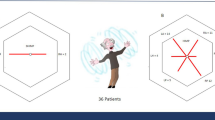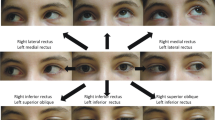Abstract
The subjective visual vertical (SVV) is a useful tool to evaluate clinical manifestations of vestibular loss, but there have been normal variations of the SVV within 1°–3°, and over time, the absolute deviated degrees of SVV tilts decreases. We investigated SVV values in patients with vestibular neuritis (VN) during eccentric rotation, the method used to assess utricular function during stimulation of one labyrinth. And we performed SVV in the resting state and during eccentric rotation to the lesion side and the healthy side of 15 patients with VN and 20 normal subjects. No difference in the resting state SVV values was observed between the VN patients and the control group, but there were significant differences in SVV values between these two groups during eccentric rotation. Therefore, SVV during eccentric rotation allowed us to obtain information about unilateral vestibular loss that could not be found by conventional SVV in patients with VN. Thus, SVV during eccentric rotation might be a good tool to diagnose unilateral vestibular loss.



Similar content being viewed by others
References
Baloh RW (2003) Vestibular neuritis. N Engl J Med 348:1027–1032
Brandt T, Dieterich M (1987) Pathological eye–head coordination in roll: tonic ocular tilt reaction in mesencephalic and medullary lesions. Brain 110:649–666
Tabak S, Collewijn H, Boumans LJ (1997) Deviation of the subjective vertical in long-standing unilateral vestibular loss. Acta Otolaryngol (Stockh) 117:1–6
Min KK, Ha JS, Kim MJ, Cho CH, Cha HE, Lee JH (2007) Use of subjective visual horizontal and vertical in patients of unilateral vestibular neuritis. Otol Neurotol 28:520–525
Kim HA, Hong JH, Lee H, Yi HA, Lee SR, Lee SY, Jang BC, Ahn BH, Baloh RW (2008) Otolith dysfunction in vestibular neuritis: recovery pattern and a predictor of symptom recovery. Neurology 70:449–453
Clarke AH, Schönfeld U, Helling K (2003) Unilateral examination of utricle and saccule function. J Vestib Res 13:215–225
Hong SM, Park MS, Cha CI, Park CH, Lee JH (2008) Subjective visual vertical during eccentric rotation in patients with benign paroxysmal positional vertigo. Otol Neurotol 29:1167–1170
Hong SM, Yeo SG, Kim SW, Cha CI (2008) The results of vestibular evoked myogenic potentials, with consideration of age-related changes, in vestibular neuritis, benign paroxysmal positional vertigo, and Meniere’s disease. Acta Otolaryngol 128:861–865
Friedmann G (1970) The judgement of the visual vertical and horizontal with peripheral and central vestibular lesion. Brain 93:313–328
Bohmer A, Rickenmann J (1995) The subjective visual vertical as a clinical parameter of vestibular function in peripheral vestibular disease. J Vestib Res 5:35–45
Tribukait A, Bergenius J, Brantberg K (1996) The subjective visual horizontal for different body tilts in the roll plane; characterization of normal subject. Brain Res Bull 40:375–383
Chae SY, Noh HI, Suh BD (2004) Normal variation of subjective visual vertical and horizontal in human. Korean J Otolaryngol 43:260–264
Bergenius J, Tribukait A, Brantberg K (1996) The subjective horizontal at different angles of roll-tilt in patients with unilateral vestibular impairment. Brain Res Bull 40:385–390
Gomez Garcia A, Jauregui-Renaud K (2003) Subjective assessment of visual verticality in follow-up of patients with acute vestibular disease. Ear Nose Throat J 82:442–444
Smith PF, Darlington CL (1991) Neurochemical mechanisms of recovery from peripheral vestibular lesions (vestibular compensation). Brain Res Rev 16:117–133
Vidal PP, De Waele C, Vibert N, Muhlethaler M (1998) Vestibular compensation revisited. Otolaryngol Head Neck Surg 119:34–42
Darlington CL, Smith PF (2000) Molecular mechanisms of recovery from vestibular damage in mammals: recent advances. Prog Neurobiol 62:313–325
Acknowledgment
This work was supported by a grant (Code # 200810FTH010103002) from BioGreen21 Program, Rural Development Administration, Republic of Korea.
Author information
Authors and Affiliations
Corresponding author
Rights and permissions
About this article
Cite this article
Hong, S.M., Yeo, S.G., Byun, J.Y. et al. Subjective visual vertical during eccentric rotation in patients with vestibular neuritis. Eur Arch Otorhinolaryngol 267, 357–361 (2010). https://doi.org/10.1007/s00405-009-1064-y
Received:
Accepted:
Published:
Issue Date:
DOI: https://doi.org/10.1007/s00405-009-1064-y




